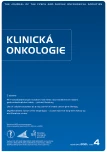Anisocoria as a side effect of paclitaxel treatment
Authors:
J. Halámková 1; D. Adámková Krákorová 1; R. Demlová 2,3
Authors‘ workplace:
Klinika komplexní onkologické péče LF MU a MOÚ, Brno
1; Farmakologický ústav, LF MU Brno
2; Oddělení klinického hodnocení, MOÚ Brno
3
Published in:
Klin Onkol 2021; 34(4): 306-308
Category:
Case Report
doi:
https://doi.org/10.48095/ccko2021306
Overview
Background: Paclitaxel is one of the most common cytostatics used in oncology; it is part of the therapeutic protocols of many malignancies. One of its most common side effects is peripheral neuropathy. This symptomatology often leads to a reduction in the dose intensity of chemotherapeutic drugs or to early discontinuation of the treatment. Case: In our case report, we describe a rare case of paclitaxel-induced anisocoria in a young woman with breast cancer. Conclusion: Ocular side effects related to taxanes are rare, with an estimated frequency of about 1%. In addition to relatively frequent obstruction of the nasolacrimal duct, the cystoid macular edema or ischemic retinopathy have been reported. However, in most cases paclitaxel-induced ocular side effects, there is no need to reduce or discontinue therapy. However, the collaboration of an oncologist with an experienced and trained ophthalmologist is essential.
Keywords:
anisocoria – paclitaxel – chemotherapy-induced polyneuropathy – CIPN
Sources
1. Weaver BA. How Taxol/paclitaxel kills cancer cells. Mol Biol Cell 2014; 25 (18): 2677–2681. doi: 10.1091/mbc.E14-04-0916.
2. Reyes-Gibby CC, Morrow PK, Buzdar A et al. Chemotherapy-induced peripheral neuropathy as a predictor of neuropathic pain in breast cancer patients previously treated with paclitaxel. J Pain 2009; 10 (11): 1146–1150. doi: 10.1016/j.jpain.2009.04.006.
3. Seretny M, Currie GL, Sena ES et al. Incidence, prevalence, and predictors of chemotherapy-induced peripheral neuropathy: a systematic review and meta-analysis. Pain 2014; 155 (12): 2461–2470. doi: 10.1016/j.pain.2014.09.020.
4. Martinez JW, Sanchez-Naranjo JC, Londono-De Los Rios PA et al. Prevalence of peripheral neuropathy associated with chemotherapy in four oncology centers of Colombia. Rev Neurol 2019; 69 (3): 94–98. doi: 10.33588/rn.6903.2019035.
5. Zajączkowska R, Kocot-Kępska M, Leppert W et al. Mechanisms of chemotherapy-induced peripheral neuropathy. Int J Mol Sci 2019; 20 (6): 1451. doi: 10.3390/ijms20061451.
6. SPC Taxol. [online]. Dostupné z: https: //www.sukl.cz/modules/medication/detail.php?code=0076204 &tab=texts.
7. Fortes BH, Liou H, Dalvin LA. Ophthalmic adverse effects of taxanes: the Mayo Clinic experience. Eur J Ophthalmol 2020. [In press]. doi: 10.1177/1120672120969045.
8. Tanaka Y, Bando H, Hara H et al. Cystoid macular edema induced by nab-paclitaxel. Breast Cancer 2015; 22 (3): 324–326. doi: 10.1007/s12282-012-0373-y.
9. Smith SV, Benz MS, Brown DM. Cystoid macular edema secondary to albumin-bound paclitaxel therapy. Arch Ophthalmol 2008; 126: 1605–1606. doi: 10.1001/archopht.126.11.1605.
10. Das A, Ranjan R, Shah PK et al. Paclitaxel- and/or cyclophosphamide-induced severe 10. ischaemic retinopathy. Clin Exp Ophthalmol 2020; 48 (8): 1113–1115. doi: 10.1111/ceo.13854.
Labels
Paediatric clinical oncology Surgery Clinical oncologyArticle was published in
Clinical Oncology

2021 Issue 4
Most read in this issue
- Basic information for identifying psychological disorders caused by malignant disease
- Anisocoria as a side effect of paclitaxel treatment
- Somatostatin receptor PET beyond the neuroendocrine tumors of the gastrointestinal tract – the review of literature
- Cancer-associated thrombosis – treatment and prevention with direct oral factor Xa inhibitors
